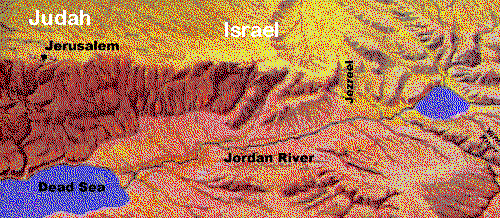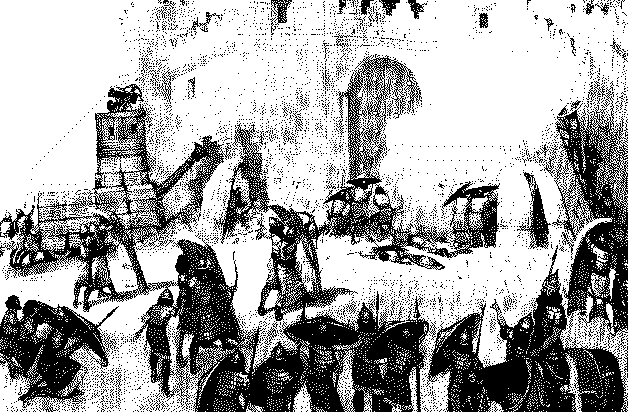"But as for the children of Israel
which dwelt in the cities of Judah, Rehoboam reigned over them. Then king
Rehoboam sent Adoram, who [was] over the tribute; and all Israel stoned him with
stones, that he died. Therefore king Rehoboam made speed to get him up to his
chariot, to flee to Jerusalem. So Israel rebelled against the house of David
unto this day. And it came to pass, when all Israel heard that Jeroboam was come
again, that they sent and called him unto the congregation, and made him king
over all Israel"
- 1 Kings 12:17-20
The Old Testament - A Brief Overview
The Southern Kingdom (Judah)

The Southern Kingdom consisted of 2 tribes (Judah and Benjamin). The kingdom extended in the north as far as Bethel, while in the south it ended in the dry area known as the Negev. Its eastern and western boundaries were the Jordan River and the Mediterranean Sea. Jerusalem was its capital and it lasted from about 922-586 B.C.
Judah was left suddenly independent when Rehoboam flatly refused to lighten the heavy load of forced labor and high taxation imposed on the Israelites by his father Solomon (1 Kin. 12:1-24). Upon Rehoboam's refusal, the ten tribes living north of Bethel promptly declared their independence.
 But
something else occurred along with this Division. An entirely unexpected blow
that devastated Judah. Shishak, Pharaoh of Egypt, invaded the country, plundered
the treasures of the Temple and the royal palace, and destroyed a number of
newly built fortresses (2 Chr. 12:1-12). Judah never recovered from the sudden
loss of her national wealth. Because her land was not as fertile as that of the
northern kingdom of Israel, Judah never enjoyed the same degree of prosperity.
Rehoboam wanted to attack Israel and reunite the kingdom by force, but a Word
from the Lord came to Shemaiah the prophet saying,
But
something else occurred along with this Division. An entirely unexpected blow
that devastated Judah. Shishak, Pharaoh of Egypt, invaded the country, plundered
the treasures of the Temple and the royal palace, and destroyed a number of
newly built fortresses (2 Chr. 12:1-12). Judah never recovered from the sudden
loss of her national wealth. Because her land was not as fertile as that of the
northern kingdom of Israel, Judah never enjoyed the same degree of prosperity.
Rehoboam wanted to attack Israel and reunite the kingdom by force, but a Word
from the Lord came to Shemaiah the prophet saying,
Judah had somewhat of a better record. Only 8 of Judah's kings served God. These were: Asa, Jehoshaphat, Joash, Amaziah, Uzziah, Jotham, Hezekiah, and Josiah. The rest of the 20 kings were wicked. In the southern kingdom there was only one dynasty, that of king David, except usurper Athaliah from the northern kingdom, who by marriage, broke into David's line, and interrupted the succession for 6 years, 20 kings in all. An average of about 16 years to a reign.
Jehoshaphat's son Jehoram (about 848-841 B.C.) married Athaliah, daughter of king Ahab and the wicked Queen Jezebel; and their marriage led to Baal worship also being established in Jerusalem (2 Kin. 8:18). Jehoram's son Ahaziah reigned only for one year (841 B.C.) before he was killed. The pagan queen-mother Athaliah seized the throne and nearly brought the Davidic line to extinction by killing most of Ahaziah's sons. Only the infant Joash escaped; he was rescued by his aunt Jehoshabeath and her husband Jehoiada, the godly high priest (2 Chr. 22:10-12). After six years Joash was proclaimed the lawful king, and Athaliah was executed.Baal worship climaxed in Judah during the reign of Ahaz (2 Ki 16). Ahaz (about 732-715 B.C.), was faced with Assyria's rise to power under TiglathPileser III; but Ahaz resisted the urgings of Rezin of Syria and Pekah of Israel to join an alliance against Assyria. Instead, Ahaz sought help from Assyria, against the prophet Isaiah's advice, and received assistance in return for heavy tribute. Syria and the kingdom of Israel were destroyed in 722 B.C., leaving Judah at the mercy of the Assyrians.
Isa 37:33-38 "Therefore thus says the LORD concerning the king of Assyria: 'He shall not come into this city, nor shoot an arrow there, nor come before it with shield, nor build a siege mound against it. By the way that he came, by the same shall he return; and he shall not come into this city,' says the LORD. 'For I will defend this city, to save it for My own sake and for My servant David's sake.' "Then the angel of the LORD went out, and killed in the camp of the Assyrians one hundred and eighty-five thousand; and when people arose early in the morning, there were the corpses-- all dead. So Sennacherib king of Assyria departed and went away, returned home, and remained at Nineveh. Now it came to pass, as he was worshiping in the house of Nisroch his god, that his sons Adrammelech and Sharezer struck him down with the sword; and they escaped into the land of Ararat. Then Esarhaddon his son reigned in his place.
Revival came during the reign of Hezekiah but it was immediately swept aside by Manasseh, who was Judah's most wicked and longest ruling king. The nation never fully recovered from the effects of this evil king. Manasseh's son Amon continued in his father's depravity, but he soon was murdered. His successor Josiah (about 640-609 B.C.) restored traditional covenant religion, which was based on the Book of the Law newly discovered in a Temple storeroom (2 Chr. 34:14). Many did not follow Josiah's example, however, and the prophet Zephaniah foretold disaster for the nation. By 610 B.C. the Assyrian Empire had collapsed under Babylonian attacks, and Babylon prepared to march against Egypt, which had been helping the Assyrians. Against Jeremiah's advice, Josiah intervened and was killed at Megiddo.

� Free Bible (https://free-bible.com)
Read The Bible
- 1599 Geneva Bible (GNV)
- 21st Century King James Version (KJ21)
- American Standard Version (ASV)
- Amplified Bible (AMP)
- Amplified Bible, Classic Edition (AMPC)
- Authorized (King James) Version (AKJV)
- BRG Bible (BRG)
- Christian Standard Bible (CSB)
- Common English Bible (CEB)
- Complete Jewish Bible (CJB)
- Contemporary English Version (CEV)
- Darby Translation (DARBY)
- Disciples’ Literal New Testament (DLNT)
- Douay-Rheims 1899 American Edition (DRA)
- Easy-to-Read Version (ERV)
- English Standard Version (ESV)
- English Standard Version Anglicised (ESVUK)
- Evangelical Heritage Version (EHV)
- Expanded Bible (EXB)
- GOD’S WORD Translation (GW)
- Good News Translation (GNT)
- Holman Christian Standard Bible (HCSB)
- International Children’s Bible (ICB)
- International Standard Version (ISV)
- J.B. Phillips New Testament (PHILLIPS)
- Jubilee Bible 2000 (JUB)
- King James Version (KJV)
- Lexham English Bible (LEB)
- Living Bible (TLB)
- Modern English Version (MEV)
- Mounce Reverse Interlinear New Testament (MOUNCE)
- Names of God Bible (NOG)
- New American Bible (Revised Edition) (NABRE)
- New American Standard Bible (NASB)
- New American Standard Bible 1995 (NASB1995)
- New Catholic Bible (NCB)
- New Century Version (NCV)
- New English Translation (NET)
- New International Reader's Version (NIRV)
- New International Version - UK (NIVUK)
- New International Version (NIV)
- New King James Version (NKJV)
- New Life Version (NLV)
- New Living Translation (NLT)
- New Matthew Bible (NMB)
- New Revised Standard Version (NRSV)
- New Revised Standard Version Catholic Edition (NRSVCE)
- New Revised Standard Version, Anglicised (NRSVA)
- New Revised Standard Version, Anglicised Catholic Edition (NRSVACE)
- New Testament for Everyone (NTE)
- Orthodox Jewish Bible (OJB)
- Revised Geneva Translation (RGT)
- Revised Standard Version (RSV)
- Revised Standard Version Catholic Edition (RSVCE)
- The Message (MSG)
- The Voice (VOICE)
- Tree of Life Version (TLV)
- World English Bible (WEB)
- Worldwide English (New Testament) (WE)
- Wycliffe Bible (WYC)
- Young's Literal Translation (YLT)
Table of Contents
The Story of the Bible
- The Old Testament
- Quick Summary
- About
- Divisions
- Timeline
- Charts
- Maps
- Creation
- Adam and Eve
- The Flood
- The Tower of Babel
- Abraham the First Hebrew
Isaac, Son of Promise
- Jacob and the 12 Tribes
- Joseph and Egypt
- Moses and the Exodus
- The Giving of the Law
- The Tabernacle
- The Wilderness Wanderings
- Joshua and the Promised Land
- The Judges
- Samuel the Prophet
- Saul, Israel's First King
- King David
- King Solomon
- The Divided Kingdom
- The Northern Kingdom of Israel
- The Southern Kingdom of Judah
- The Assyrian Captivity
- The Babylonian Captivity
- The Return From Babylon
- The Prophets
- The Messiah
- Conclusion
- Bibliography and Credits
Summary of the Old Testament Books
- Genesis
- Exodus
- Leviticus
- Numbers
- Deuteronomy
- Joshua
- Judges
- Ruth
- Samuel
- Kings
- Chronicles
- Ezra
- Nehemiah
- Esther
- Job
- Psalms
- Proverbs
- Ecclesiastes
- Song of Solomon
- Isaiah
- Jeremiah
- Lamentations
- Ezekiel
- Daniel
- Hosea
- Joel
- Amos
- Obadiah
- Jonah
- Micah
- Nahum
- Habakkuk
- Zephaniah
- Haggai
- Zechariah
- Malachi
Read the Old Testament Stories
Bibliography Resources on the Old Testament
- A Survey of Old Testament Introduction, Revised and Expanded by Archer, 508 Pages, Pub. 2007
- The Old Testament: A Historical, Theological, and Critical Introduction
- Introducing the Old Testament: A Historical, Literary, and Theological Survey
- A Survey of the Old Testament
- An Introduction to the Old Testament: Second Edition
- Old Testament Theology
- A Biblical-Theological Introduction to the Old Testament: The Gospel Promised
Old Testament Charts to Help with the Study of the Bible
- Old Testament Books
- Old Testament Books in English Order
- Old Testament Books in Hebrew Order
- Old Testament Books - Hebrew Meanings
- Divisions of the Old Testament
- Timeline of the Pentateuch
- Adam and Eve, a Type of Christ and the Church
- The Table of Nations in Genesis 10
- Lifespans in Genesis
- The Lineage of Christ in Genesis
- The Family Tree of Esau
- The 12 Tribes of Israel
- Joseph, A Type of Christ
- The Encampment of Israel
- The Hebrew Calendar of Months
- The 7 Feasts and God's Calendar
- The Feasts and Festivals of Israel
- Scriptures and Procedures of the Feasts
- Chapters, Verses, and Words in the Old Testament
- Miracles in the Old Testament
- Parables in the Old Testament
- Gentile Nations in the Old Testament
- The Servant of the LORD, Israel and the Messiah
- The Distinction Between Kings and Chronicles
- The Judges who Delivered Israel
- The Royal House of David
- The Kings of Israel
- The Kings of Judah
- Chronology of Israel and Judah's Kings and Prophets
- Chronology of the Prophets
- Messages of the Prophets
- Kings of the Assyrian Empire
- Kings of the Babylonian Empire
- Kings of the Persian Empire
- Cuneiform Inscriptions with Names of Foreign Kings
Main Menu
- Ancient Assyrian Social Structure
- Ancient Babylonia
- Ancient Canaan During the Time of Joshua
- Ancient History Timeline
- Ancient Oil Lamps
- Antonia Fortress
- Archaeology of Ancient Assyria
- Assyria and Bible Prophecy
- Augustus Caesar
- Background Bible Study
- Bible
- Biblical Geography
- Fallen Empires - Archaeological Discoveries and the Bible
- First Century Jerusalem
- Glossary of Latin Words
- Herod Agrippa I
- Herod Antipas
- Herod the Great
- Herod's Temple
- High Priest's in New Testament Times
- Jewish Literature in New Testament Times
- Library collection
- Map of David's Kingdom
- Map of the Divided Kingdom - Israel and Judah
- Map of the Ministry of Jesus
- Matthew Henry Bible Commentary
- Messianic Prophecy
- Nero Caesar Emperor
- Online Bible Maps
- Paul's First Missionary Journey
- Paul's Second Missionary Journey
- Paul's Third Missionary Journey
- Pontius Pilate
- Questions About the Ancient World
- Tabernacle of Ancient Israel
- Tax Collectors in New Testament Times
- The Babylonian Captivity
- The Black Obelisk of Shalmaneser
- The Books of the New Testament
- The Court of the Gentiles
- The Court of the Women in the Temple
- The Destruction of Israel
- The Fall of Judah with Map
- The History Of Rome
- The Incredible Bible
- The Jewish Calendar in Ancient Hebrew History
- The Life of Jesus in Chronological Order
- The Life of Jesus in Harmony
- The Names of God
- The New Testament
- The Old Testament
- The Passion of the Christ
- The Pharisees
- The Sacred Year of Israel in New Testament Times
- The Samaritans
- The Scribes
Ancient Questions
- Why Do the Huldah Gates Appear Different in Ancient Replicas and Modern Photos?
- What Is the Origin of the Japanese and Chinese Peoples? A Biblical Perspective
- How did the ancient Greeks and Romans practice medicine and treat illnesses?
- What were the major contributions of ancient Babylon to mathematics and astronomy?
- How did the ancient Persians create and administer their vast empire?
- What were the cultural and artistic achievements of ancient India, particularly during the Gupta Empire?
- How did ancient civilizations like the Incas and Aztecs build their remarkable cities and structures?
- What were the major trade routes and trading practices of the ancient world?
- What was the role of slavery in ancient societies like Rome and Greece?
- How did the ancient Mayans develop their sophisticated calendar system?
Bible Study Questions
- Why Do Christians Celebrate Christmas?
- How Many Chapters Are There in the Bible?
- The Five Key Visions in the New Testament
- The 400-Year Prophecy: Unpacking Genesis 15 and the Journey of a People
- The Authorized (King James) Version (AKJV): Historical Significance, Translation Methodology, and Lasting Impact
- Exploring the English Standard Version (ESV): Its Aspects, Comparisons, Impact on Biblical Studies, and Church Use
- A Detailed Historical Analysis of Language Updates in the KJ21: Comparison with Other Versions
- A Detailed Historical Analysis of the American Standard Version (ASV): Comparison to the King James Version, Influence on Later Translations, and Evaluation of Strengths and Weaknesses
- A Detailed Historical Analysis of Amplifications in the Amplified Bible (AMP) and Its Comparison to Other Bible Translations
- Detailed Historical Analysis of the Amplified Bible Classic Edition (AMPC): Examples of Amplifications and Comparative Analysis with Other Bible Translations
About
Welcome to Free Bible: Unearthing the Past, Illuminating the Present! Step into a world where ancient history and biblical narratives intertwine, inviting you to explore the rich tapestry of human civilization.
Discover the captivating stories of forgotten empires, delve into the customs and cultures of our ancestors, and witness the remarkable findings unearthed by dedicated archaeologists.
Immerse yourself in a treasure trove of knowledge, where the past comes alive and illuminates our understanding of the present.
Join us on this extraordinary journey through time, where curiosity is rewarded and ancient mysteries await your exploration.
Recent posts
-

How Pallet Restacking Supports ESG Goals in the U.S. Industrial Sector and Drives Long-Term Value in Warehousing
Pallet restacking plays a pivotal role in supporting Environmental, Social, and Governance (ESG) goals across the U.S. industrial sector. As businesse... -

How Platzi AI Hiprex Trading Algorithms Are Outperforming Human Investors in 2025
The financial markets of 2025 are quicker, more complex, and extra records-pushed than ever earlier than. In this high-speed environment, even the max... -

Retail Traders Gain Edge with Quantum AI-Powered Market Insights
In these days’s hastily evolving monetary markets, technology is no longer only a device—it’s a competitive benefit. While institutional traders... -

Quantum AI Sets New Standard in Predictive Trading Accuracy
The monetary international isn't any stranger to change, but few innovations have disrupted conventional buying and selling pretty like synthetic inte... -

AI-Powered Trading Apps See Record Growth Among First-Time Investors
The panorama of investing is changing rapid. What was ruled through skilled investors and large institutions is now beginning up to a brand new genera...